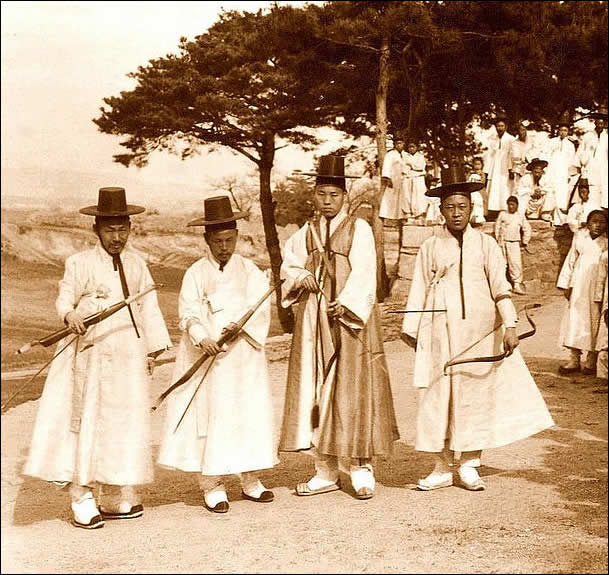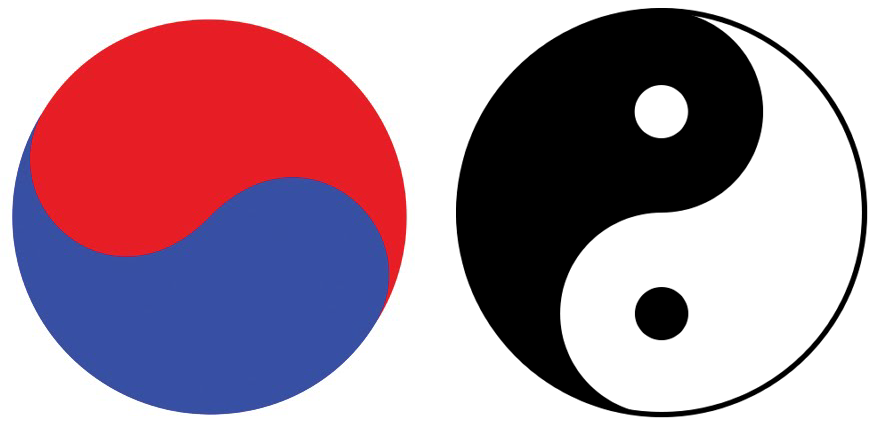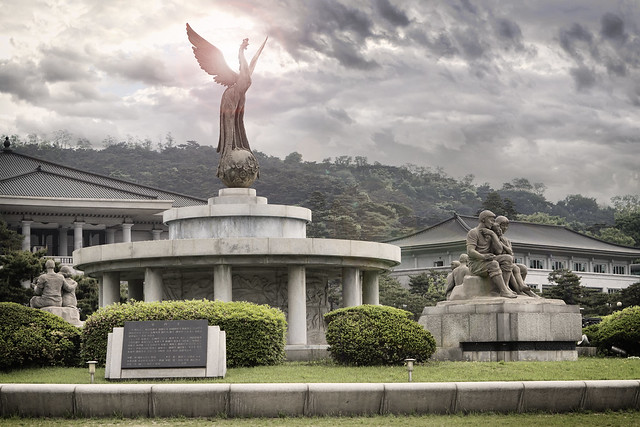So when you think of South Korea what do you think of? King Sejong, Yi Sun Sin, or even K-Pop definitely could come to mind. Yet, what about the signs that represent Korea? The South Korean flag or the Taeguk are very distinct, but have you ever stopped and wondered what they mean and represent?
The Flag of South Korea, Taegukgi (태극기)
History

Korea did not have a national flag until 1883. Before that time the kingdoms of Korea did not think it necessary or important to create a flag. The first time this became an issue was in 1876 during the Joseon Dynasty. During this time negotiations were ongoing for the Japan-Korea Treaty of 1876, or in Korea known as the Treaty of Ganghwa Island. The Empire of Japan had sent a delegate to the negotiations with a flag to hang next to the flag of the Joseon Kingdom. Since there was no flag it was proposed that one be created.

The idea was still considered unimportant, but was brought up again in 1880 by a Chinese delegate who wanted to create a flag that combined the flag of the Quing dynasty with elements of the Joseon Dynasty. Some ideas from this proposal known as the “Korean Strategy” papers were used in the final design for the first flag, but the idea was again put aside until 1882. (The flag that was designed from this proposal became the flag of the King.)

When the United States-Korea Treaty of 1882 was in delegation, a time when many other countries were also recognizing Korea separate from China, the Joseon Dynasty decided it was time to create their own flag. The design for the flag was came about when a delegate proposed an idea for the flag that seemed too similar to the flag of Japan to the Chinese official, Ma Jianzhong. The official did not like the design, or the idea of Korea using the Flag of the Quing Dynasty. Instead he proposed a flag with a white background, with a half-red and half-black circle in the center, with eight black bars around the flag. The Taegukgi became the official flag of the Joseon government, which was declared in March 1883.

The Taegukgi went through a number of redesigns before the current version was designed on July 12, 1948. The current design of the Taegukgi was used for all of Korea until the separation of North and South Korea. The current flag was then declared as the official national flag of the Republic of Korea (South Korea) on October 15, 1949.
Symbolism
There is a lot of meaning within the South Korean flag even though it has a very simplistic design. The flag has three main parts: the white background, the red and blue circle in the center, and the four trigrams in each corner of the flag. Taegukgi (태극기) is the translation from the Chinese version of the word, 太極旗, meaning the “grand ultimate flag” (Taeguk meaning “Grand Ultimate” and Gi meaning “flag”).

The white background of the flag can represent peace, and is also a reference to the Korean people, because they used to be known as the “white clothed people”.

The flag “Taegukgi” gets its name from the red and blue centered circle which is called the “Taeguk” (태극). It looks very much like the Chinese Taijitu because it is the Korean version of it. Many will see the Taijitu and think of it as the “Yin and Yang” which is actually the translated name of the philosophy of “Taiji“. The central philosophy of Taiji is that it represents perfect harmony and balance “a continuous movement within the sphere of infinity, resulting in one unit”. This is all represented through the Taeguk which instead of using “Yin and Yang” to represent the separate halves, uses “Eum and Yang”. The blue half of the circle represents all that is negative in the universe and is called “Eum”, while the red half is named “Yang” and represents all that is positive. While thought of separately Eum and Yang both represent the duality of the world, but together they form a circle symbolizing unity. There are many examples of duality present in our everyday lives: good and evil, light and dark, heaven and hell, Republicans and Democrats, even Blackjacks and Sones.

The original flag of the Joseon King had the eight trigrams, a set of three lines, of Taoist Cosmology on it. Each line within the trigrams either represent Eum (broken line) or Yang (unbroken line). The flag now has what Koreans consider the four most important trigrams, or “kwae” (괘), set in each corner of the flag. The trigrams on the flag are as follows: upper left “geon” (건), upper right “gam” (감), bottom left “ri” (리), and bottom right “gon”(곤). Each one of them also has a specific set of meanings that are attributed to them and the most common one is the classical elements: heaven, water, fire, earth. They are also set up to display their opposite meanings much like the Taeguk. Heaven (geon) is set in the upper left opposite of Earth (gon) which is set in the bottom right, and the same is true about Water (gam) and Fire (ri) which are also opposites. One can also see that the trigrams themselves are opposites based off of their broken and unbroken lines (example three unbroken positive bars representing Heaven and three broken negative bars representing Earth).
Tricolored Taegeuk (삼색의태극)

While you can see the Taeguk and Korean flag just about anywhere in South Korea you can also see this variant of the Taeguk in many places, especially on traditional architecture such as the main gates and palaces. It is called the Sam Saeg-ui Taegeuk or Samtaeguk adds an extra “pa” (파) to the red and blue symbol. Yellow is added to the mix which represents Humanity, along with red for Heaven and blue for Earth. This was a popular depiction to better explain how everything coexisted together in the world: Heaven has direct influence on Earth, Earth has direct influence on Humanity, and Humanity has direct influence on Heaven.
Government Emblems
National Emblem of the Republic of Korea

You can find this when you are looking at different country representations. The main focus is obviously the Taeguk which was explained earlier.

It is enclosed by South Korea’s national flower the “Mugunghwa ” (무궁화), its scientific name is the Hibiscus syriacus and in North America is known as the “Rose of Sharon”. The significance of the flower comes from the Korean word “mugung” which can translate to forever or eternity. This fact and that the country is poetically compared to the flower in the South Korean National Anthem, makes this flower the perfect choice for the emblem. To finish off the symbol at the bottom on a white banner is written “대한민국” (Daehan Minguk) which means Republic of Korea. So essentially the symbol represents the idea of positive and negative forces remaining in balance for all eternity.
Emblem of the Prime Minister

This is the emblem of the prime minister of South Korea whose office is currently held by Jung Hong-won (정홍원) (he has officially resigned as Prime Minister but will still hold the office until a replacement is chosen). The Prime Minister position is very similar to the Vice Presidency in the United States, including that they are second in line to the Presidency should the President not be able to fulfill their duties. The emblem is a Mugunghwa inside of a Mugunghwa which can be viewed as an eternity within an eternity. This could mean the hope that this position will continue to exist for eternity, because the Prime Minister position was used to replace the Vice Presidency for the creation of the South Korean government in 1948.
Seal of the President

The current president in South Korea is Park Geun-hye (박근혜) and she is also the first female president in the country. This is the seal used to represent her and all the past presidents of South Korea. The blue background represents the Earth and government, while the gold/yellow coloring of the symbols represents humanity (it is also a color that has long represented the royalty of Korea).

A new symbol on the emblem are the two “Bonghwang” (봉황) facing each other, it is the Korean version of the Chinese “Fenghuang” which is sometimes translated to Phoenix. The Bonghwang is said to be “composed of the beak of a rooster, the face of a swallow, the forehead of a fowl, the neck of a snake, the breast of a goose, the back of a tortoise, the hindquarters of a stag, and the tail of a fish”. These Korean Phoenixes also have a long history of being depictions of royalty and authority. So putting two bonghwang over a Mugunghwa could symbolize hope that the president will forever have authority.
These are some of the main symbols that can be found within South Korea. Of course there are many others and lots more meanings to each of them. Can you think of any other symbols that are important to South Korea that have been left out? Leave them in the comments below!
Sources:
- Flag History – Korea’s Appeal to the Conference on Limitation of Armament, Chosun.com, Flags of Maritime Nations, Encyclopedia of Korean Culture
- Flag Symbolism – KNU Times, Hubert Herald, LAWnB
- Taegukgi – Cafe983
- Tricolored Taegukgi – Cafe983
- Korea Motto – A New Way of Seeing CSR
- Extra Photos – Pilgrim With A Passport
- Extra Information – Hubert Herald
Did you like the post? If so:
Please follow, like, or subscribe to us on WordPress, Facebook,YouTube, Twitter, or Instagram. It would help us out a lot, and keep you up to date on all things KCE!
Erin~


